Malcolm Roads beach and little Ghost Crab. I photographed it for at least twenty minutes. I wanted to capture the ocean turquoise background and the beach.
Marta

Malcolm Roads beach and little Ghost Crab. I photographed it for at least twenty minutes. I wanted to capture the ocean turquoise background and the beach.
Marta
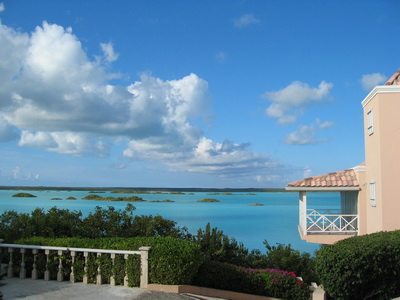
My favourite photo of Chalk Sound taken from the road infront of this private home with its' own Juliet balcony
Many peoples introduction to Chalk Sound is from the air coming into the airport. It has the most spectacular turquoise colourations dotted with mini cays or islands. For those of you familiar with our second home in Banff, Alberta, Canada…..we have Peyto Lake which has similar turquoise colour that is due to glacial rock particles that are suspended in the water.
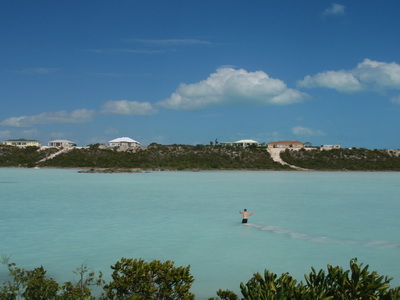
We were lunching at Las Brisas Restaurant one day and I happened to catch some photos of this gentleman going for a swim
Chalk Sound is variously referred to as a large lake, a land locked lagoon, a large natural creek , a bay or sound as well as an inland waterway. Take your pick. It is shallow and silty and you can see the clouds of fine sand particles kicked up by the above swimmer. That’s what gives the water its stunning turquoise colour.
Chalk Sound is a national park and is approximately three miles long (5 km) and lies in the south west part of Providenciales. At one time in the early 1900’s it was leased for raising and canning turtles, lobster and shellfish. Mr George Silly ( a part of Chalk Sound called Silly Creek still retains his name ) lived on a barren bluff between the two entrances to Chalk Sound in a thatched roofed cottage and he had a small shop and a cannery there.
The history of Chalk Sound revolves around various commercial enterprises such as mentioned above. George Silly also leased Chalk Sound and tried to rejuvenate the sponge industry. He had 250,000 cuttings of reef sponges sown. He continued this experiment of planting sponge beds but the operation died out after his death in 1917 and was abandonned after the war.
Today Chalk Sound is lined with spectacular homes but you can rent kayaks from Las Brisas Restaurant or perhaps be lucky enough to see the kids learning how to sail a Caicos Sloop. Stop in at Las Brisas Restaurant for a delicious lunch or dinner with one of the best views on Provo. Their Paella is really good………Pina Coladas too!!
Marta
Sea Purslane grows abundantly in salty and dry habitats such as on the tiny cays just out from Harbour Club Villas and Marina. We decided to explore one day and stopped on a little cay with a spectacular view of the Five Cays shoreline.
We spotted some Rock Iguanas but they scurried away quickly as we approached. I did manage to get a photos of one though!
On one of the slopes of this little cay, a carpet of sea purslane cascaded over the rocks. Some had star shaped pink flowers that bloom throughout the year.
Sea Purslane is a succulent herb that makes for a great ground cover. It grows along beaches and along the edges of salinas and has smooth, fleshy leaves. The leaves are edible and have a salty taste. I’ll have to find out if iguanas eat the leaves as this island seemed pretty limited in the way of food.
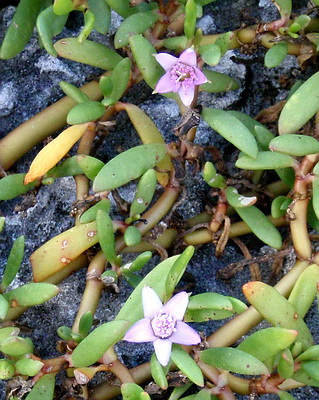
Sea Purslane is also know as Sea Pickle and can be used medicinally for treatment of scurvy and kidney disorders
What a great plant and useful for so many things!
Marta
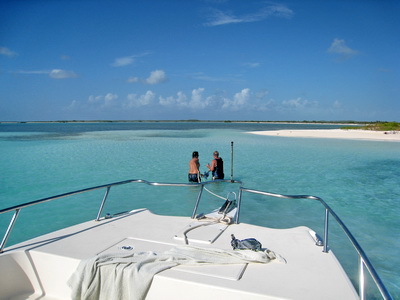
A perfect afternoon on and in the water with the boys pulling us up to the sandbar..........it simply was the best
We both had family visiting so it was an opportunity to take a leisurely run out to the sand bar at Bonefish Point. We took off from our marina at Harbour Club Villas. There’s a deep water channel ( 12 feet deep or so ) to the right of the sandbar and all of a sudden you’re in a foot of water. The guys put the anchor out and then decided to walk it into the shallows.
We saw some beautiful sea cushions ( see my previous post) and some smaller white starfish. Laura explored some rocks in the shallows and found numerous hermit crabs.
We all cooled off by staying in the water beer in hand. The Bonefish Point sandbar is on the south west tip of the island and accessible by road now. It never used to be……….the only way of getting here a few years ago was by boat or doing an excursion with Capt. Bill of Ocean Outback. This trip by the way is a great way of seeing the south shoreline. Hope you get to see this part of our island too.
Marta
The south side was rough and with white caps today so we headed off to my favourite spot on the beach in front of the Bay Bistro. Tina and Sheldon returned to the beach where they were married two years ago. They had a beautiful beach wedding ceremony and had their reception at the Bay Bistro. The water was calm and spectacularly clear as we just lolled in the water for hours with drinks in hand.
It just doesn’t get any better than this. The water was warm and sparkled in the late afternoon sun. Little Michaela came down to the beach for a swim along with her family. She told me she was just learning to swim.
The only way to describe today was “idyllic”. The water was calm with a gentle breeze blowing and only a few people on the beach enjoying the afternoon. It was raining as we got to the beach at Sibonne but I’m glad that didn’t scare us away. That’s Provo for you…….wait a few minutes, the rain stops and the sun comes out!
We hope you’ll come and enjoy all that our island has to offer.
See you soon,
Marta
Our guests at Harbour Club Villas have been out diving with Mickey and Jayne of Flamingo Divers for the past three days. What a highlight when Jayne discovered this little seahorse which was tucked away and very well hidden. It is a rare occurance to be the first to discover a new seahorse on a dive site. The dive operators here share this information with each other so they can point out the seahorse to their divers.
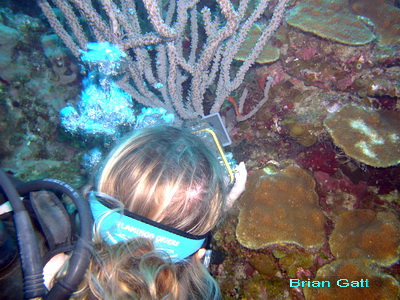
Another guest of ours Brian Gatt snapped this photo of Jayne taking a photo of another seahorse (see the orange tail ) they came across last year
Seahorses vary in colour including orange, red, yellows, grey and greens and they change colours to blend in with their surroundings. They are not good swimmers and are most likely to be seen resting in sea grass beds or coral reefs with their prehensile tail wrapped around something that is stationary.
Seahorses only have one mate and it is the male that gives birth to its live young. The female seahorse lays eggs directly into the male’s pouch on his abdomen where he immediately fertilizes them as they are deposited. One or two months later he gives birth to tiny replicas of the adults.
We hope you are lucky enough to see one of these rare creatures when out diving in the clear waters and on our coral reefs in the Turks and Caicos Islands. If you are looking for some great diving, give Flamingo Divers a call………Mickey and Jayne are the best and give an exceptionally personalized service to all who dive with them.
See you under the water as you dive and explore our reefs.
Marta
Lobster season opens today and I’m sure all available boats will be out today fishing for lobster. The Caribbean Spiny Lobster is also known as langouste, rock lobster, crayfish and crawfish and they tend to shelter in crevices of rocks and coral reefs during the day and coming out at night to feed. They have a striped body, brown-gray in colour with yellow spots on the segmented tail.
In the Turks and Caicos Islands lobster season is from Aug 1 to March 31 and some of our fishermen learned to dive at a young age and have inherited their knowledge of lobster from their fathers or other family members.
Boats usually carry team of 2 to 4 fishermen and since the fishing boats have a shallow draft, they can stop directly over patch reefs on the Caicos Banks. The spiny lobsters are found hiding in crevices and under coral outcroppings.
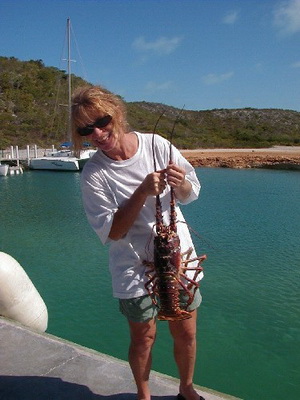
I couldn't resist putting in this photo as this was simply the biggest lobster I've ever seen. It was huge!
Our guests at Harbour Club Villas will be heading to Baci’s Ristorante this evening where John will be preparing a delicious lobster feast for this evenings diners. Come on down to Baci’s for fine dining in an Italian terrazzo style ambiance nightly fresh fish and lobster specials. Hope to see you there!
Marta
On numerous trips out to Bonefish Point, we have always spotted these brilliantly orange Cushion Stars which are thick bodied species of starfish with short legs. On this particular day, the sky and water were exceptionally clear and the cushion star was actually lying on the sand in very shallow water.
Cushion Stars are echinoderms which are found decorating our reefs all around the world. Here in the Turks and Caicos Islands we find and see them frequently in many areas usually on sandy bottoms and amongst the sea grass.
All of the echinoderms move around with the use of tiny tube feet many of which have suction cups on the end of them.
This sea star ( the Cushion Star) is easily viewed and identified because of its size, colour and thickness and because it is usually found close to shore.
Take a look off the edges of the sand bar at Bonefish Point……….you’ll be sure to see several of these brightly coloured cushion stars. We’ve seen smaller brown and more yellowish ones out there too.
Marta
I love this photo of Tina, Alexis and Ania taken out at Leeward where each and every photo shows off the amazing colours of the ocean. Make sure you don’t miss this beach on Providenciales ……….. it’s simply heaven.
Marta